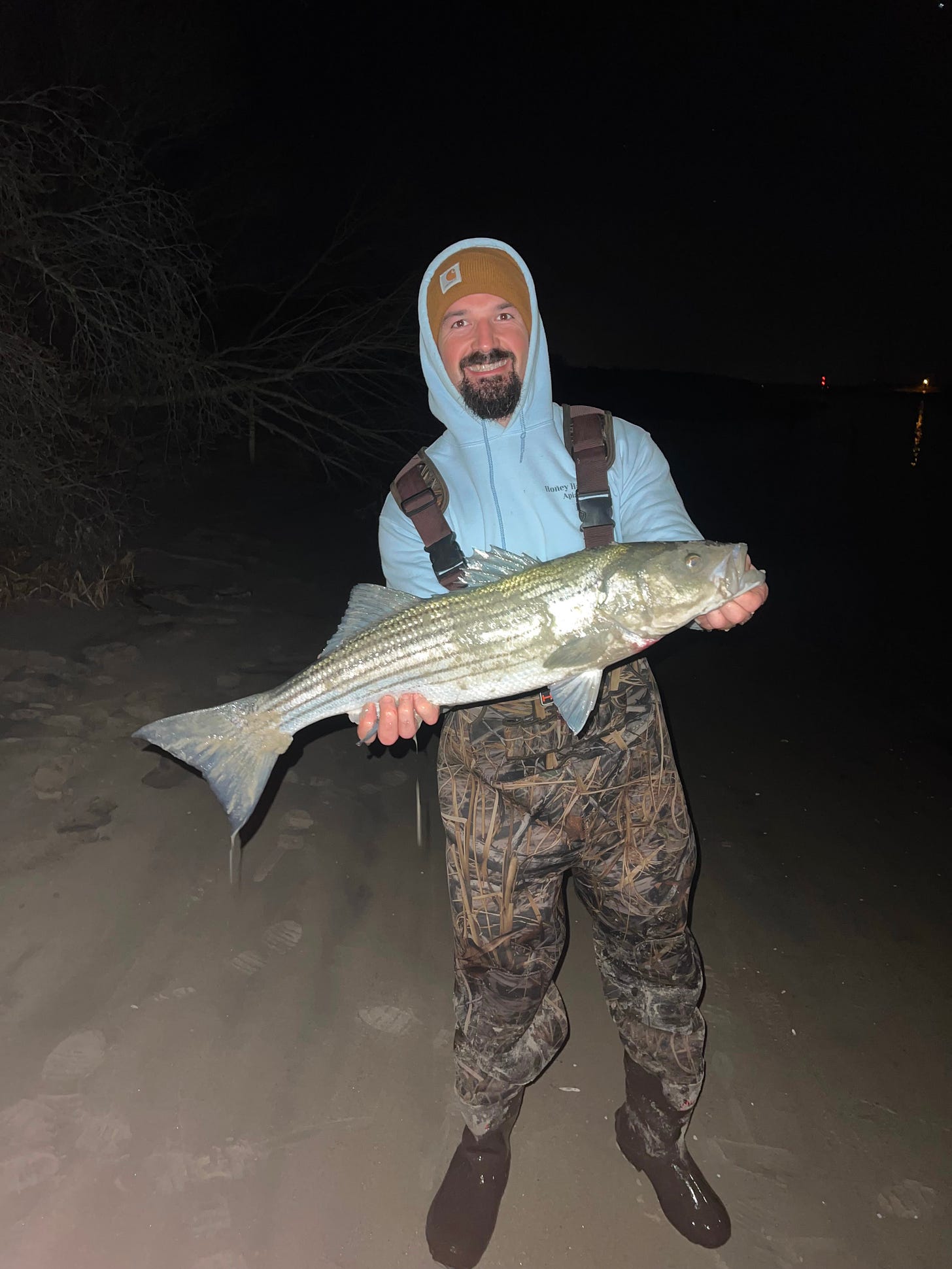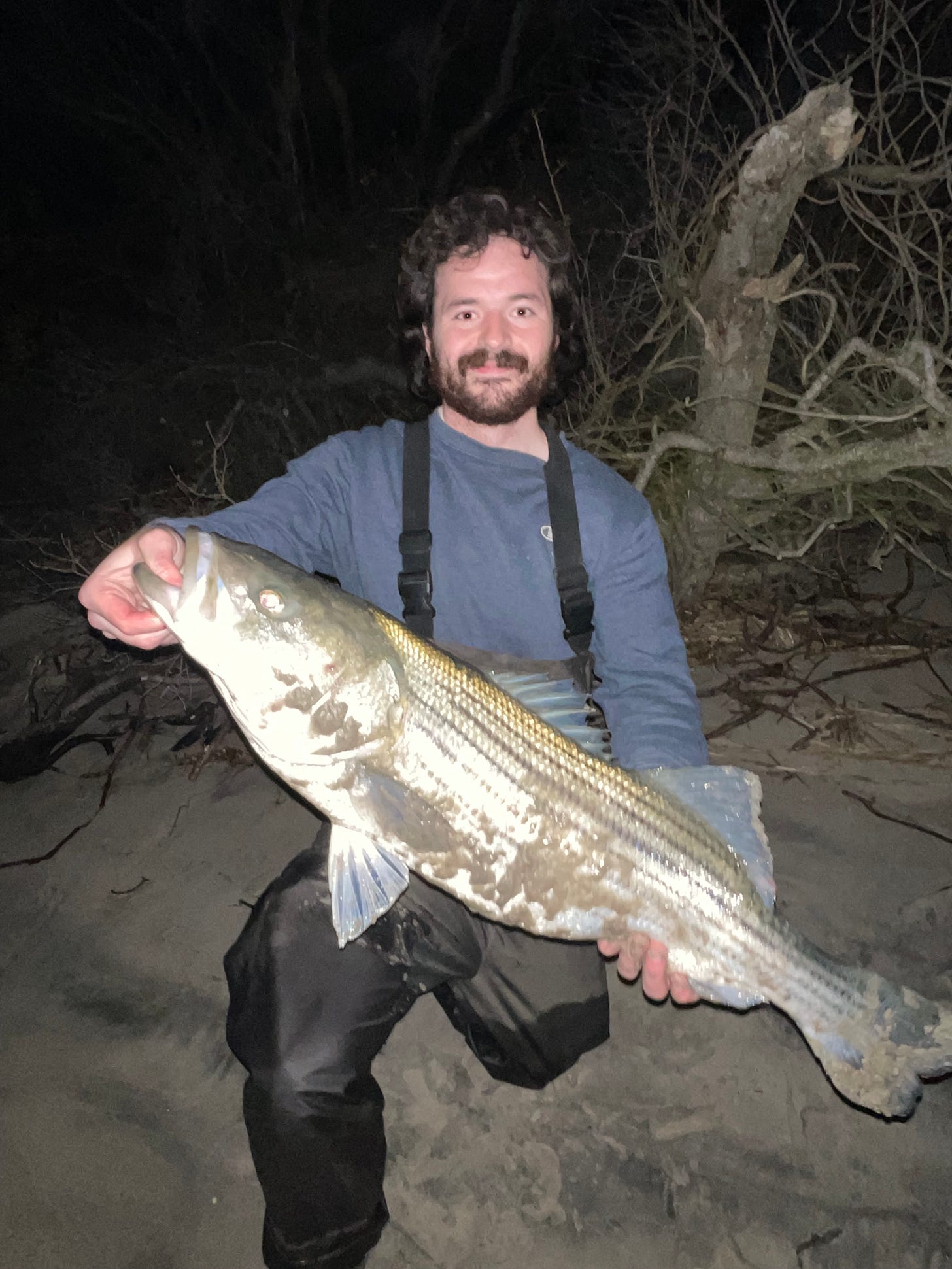The Savior Run
Sometimes, life becomes the clearest on the nights where you can't see.
In graduate school, I was tasked with finding birds where they no longer belonged. Specifically, I searched for ruffed grouse and golden-winged warblers at the far southern edge of their native range, high in the Blue Ridge Mountains of South Carolina, where biologist thought they had been extirpated by a complex mixture of human development and climate change. A small grant and a lucky job interview landed me a position as a graduate assistant. In return for earning my Master’s degree, I’d search the mountains for relic birds, and to transform my findings into something scientific, I’d have to blend birding with statistics. That was the first time I learned the power of the dark.
It was towards the end of my degree, after two field seasons, with folders of data clogging my work computer, and a 100-page thesis paper looming, that I had to tie it all together with math. Particularly, the kind of math I couldn’t do myself; the kind built for computer algorithms and coding. One week, I became stuck on a line of code that would untangle whether or not streamside rhodendron cover could predict the presence of ruffed grouse. Day after day, I wrote lines of code and the computer program spat back errors.
This next part sounds made up. But I swear it’s true.
One night in my sleep, the correct line of code manifested against a black vacuum of nothingness. The dream woke me up around midnight. I jotted the code on scrap paper. Then, I fell back to sleep. Three months later, I published my thesis, and that nocturnal epiphany brought it all together.
Tonight, I’m looking for a similar epiphany. I can’t pinpoint the problem I’m trying to solve, but it occurs every year. Beginning around late January, just as waterfowl season ends, I’m thrusted back into a life of normality. Wake up. Make coffee. Let the dog out. Get to work, come home from work, unwind, watch a movie, go to sleep. On exciting days, I go to the gym, or take an aimless ride in my boat. My dreams, instead of providing epiphanies, haunt me.
I dream about the morning fog lifting from a field of cordgrass as a flock of teal jet down a feeder stream. I dream about the hum of an outboard motor before the sun rises, the shooting stars that grace the night sky, and the thrill of being entirely alone in the wilderness. I dream about duck hunting and the marsh. I wake up to find my hunting dog, Boone, splayed on his bed, his jaw rested snug between his paws, and his eyes pinned to his forehead, looking up at me, his life, too, relegated to that of domestication. I wonder if he wonders when we will experience that rouse of adventure again. It creates a problem. Tonight, I’m trying to solve it.
It’s 9:00PM and I’m standing in the ink black waters of a tidal inlet with hermit crabs scuttling between my feet and a cloud of gnats chewing at the skin between the hairs of my head. Despite it being April, the remnant winds of winter still linger in southern New Jersey. When the breeze picks up, my body breaks out into a convulsive shiver, and if it’s not the wind stealing my heat, it’s the cold water rushing through the holes of my neoprene waders. I can’t see. I can hardly even feel, and stripped of my senses, it’s hard to imagine any kind of life thriving in this estuarine void.
But when my 7-foot Tsunami rod doubles over with a force so great that it nearly rips from my hand, I’m reminded that somewhere deep in that obsidian water, where the current races as cold and dark as the star-studded sky overhead, run thousands of migratory striped bass.
Our complex relationship with the dark dates back as far as our evolutionary roots. Most of us grew up with a fear of darkness. After all, it removes our most precious of senses, our ability to see. Without sight, we struggle to process the world around us.
What lies under the bed when your mom turns off the lights? What hides behind the closet door? Those questions used to be a bit more existential. What’s scurrying in the woods beyond the fire? I heard a twig snap, but I can’t see where it came from, is it nothing, or a hungry wolf?
Hunters and anglers know that fear best. Walk to a treestand in the predawn forest while a chorus of coyotes howl rattle the woods around you and let me know how comfortable you feel. Anglers, too, devolve into thinking about the brazen nature of sharks at night, who they imagine lurking in the shallows hunting for baitfish and fishermen’s ankles.
Psychologists believe our primeval fear of the dark starts in two places: a feeling of vulnerability and a powerful imagination. In the dark, we feel exposed, an evolutionary holdover from the days when we were lower on the food chain than where we are today, and when we sit in the dark long enough, we fill the unknown with conjurings of our own imagination. Night time beasts and fanatic fears dominate these manisfestations.
But the dark also provides the best fishing. Unlike humans, fish feel secure in the dark. Night reduces their vulnerability and cloaks them from watchful predators: humans, herons, and osprey alike. As the sun sinks beyond the horizon, gamefish feel liberated to move into the shadows to feed. Striped bass come out of their dormant daytime lull and become aggressive. These behaviors are amplified under a new moon, which makes the night even darker and drives the tides with more force. Under heavy current and pitch black conditions, striped bass thrive. Anglers can learn to thrive too if they spend enough time in the dark.
As my rod tip keels over, I grip its cork handle, white-knuckled, holding on desperately as line peels. I crank back and feel the weight of the fish. Between darting runs, I regain line. Then, the fish runs again, taking back all that I have gained. It’s an invisible tug of war. My forearm begins to ache and I feel as though I’m going to twist the cork right off my fishing rod’s handle, but the pulsing at the end of my line begins to fade. Exhaustion, and a build up of lactic acid from overworked muscles, overtake the fish. Darting sprints turn into tired head shakes. I walk backwards up the beach, and the tug of war turns into a sled drag. Saltwater drips from my waders as my fingers feel blindly for the switch of my headlamp. I turn the light on and find the pinstriped flanks of a striped bass swimming in half-moon curves just beneath the surface.
Humans may feel afraid in the dark and most comfortable in the light, but routine daily activities tax the brain. Much like the engines that power the world’s most powerful vehicles, the brain produces a lot of waste. Among its many waste products, the brain builds up a particularly harmful protein called beta amyloid. Build up too many beta amyloids, and you end up with amyloid plaques that congest the neurons of your brain. Amyloid plaques are now understood to be a primary driver of Alzheimer Disease.
And it’s not just amyloids. Tau proteins, excitotoxins, and lactate build up in our brains each day and threaten the efficiency of our neurotransmitters- our ability to think clearly, live, and experience. Unchecked, the toxic stew would destroy the brain. However, the brain comes hardwired with its own cleaning system. In our sleep, we employ a refresh tool known as neuroflushing. Through neuroflushing, our brains wash away toxins with a clear liquid known as cerebrospinal fluid. Cerebrospinal fluid rejuvenates us. It allows us to think more clearly, let go of the struggles from yesterday, and even decode complex mathematics in our sleep. We can only ever neuroflush, however, in our deepest stages of our sleep. In that respect, we can only experience life with the most clarity when we have many periods of dark.
In some abstract way, large migratory striped bass swim through the cerebrospinal fluid of anglers. They take part in an annual migration; the uncelebrated salmon run of the mid-Atlantic. It’s the savior run, a salvation from that cold and fishless chunk of year that defines the period between Christmas and the first daffodils to bloom. As the spring sun casts light on blossoming flowers and the songs of warblers decorate the warm April air, bass move under the cover of night, and light a fire to the furnace of the saltwater angler’s soul. In the dark, that fire provides light.
As I back up the beach the striped bass emerges from the whitewash, flopping on wet sand in audible smacks, kicking up spits of saltwater. I pluck the hook from its jaw and hold the bass gently by lip and tail. It’s the length of my leg and as big around as the young cedar trunks that line the beach. At an inch over New Jersey’s slot size limit, this fish will live another day. Likely, she spread the seed for the next generation before making her way down this inlet, and if all goes well, she’ll be back next year. I hold her in the water that refills her with life. She shakes her head, whips her tail, and disseapears into the darkness.
I return to the water and look across the inlet. I realize I can’t discern the horizon from the sky. It’s all black. Overhead, cool air rushes through the feathers of a mallard’s wings, and it emanates in a series of whistles coming from somewhere deep in the sky. I look up, but can’t find it. The receding tide reclaims water to the ocean. It’s force pulls at my legs. The wind halts and the whistling wings fade to silence. As the gentle waves lap in rhythm, I listen to the sound water brushing against the sand, and realize that I might after all see the world the best in the dark.
—





